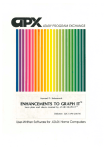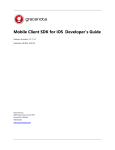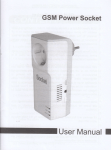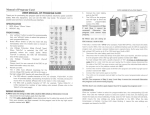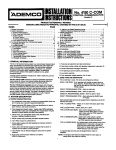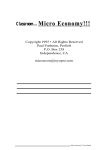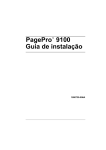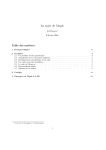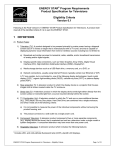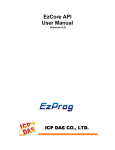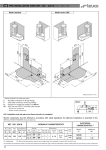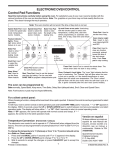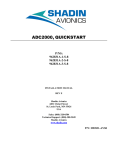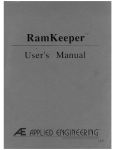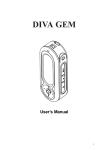Download Volume 3, Number 9
Transcript
October 1987
Vol. 3. No.9
ISSN 0885-4017
newstand price: $200
photocopy charge per page: $015
Releasing the power to everyone.
------------------------------------------------In addition tospace for lirmware, each slot also has the ""dusive use of16
bytes for accessing hardware "registers" and "softswitches" and 8 bytes of
Control-I(nterface) S(tandards)
RAM memory for remembering things.
Computerswork best in an environment of standards and compatibility. If
all computers, intenace cards, and printers were exactly the same, no one
would ever have a problem with mysterious line-breaks in the middle of a
masters thesis.
On the other band,·if everyone aIw.iys adhered to standards, and the
standard for Apple II printers was based on the technology available the day
the Apple II..". introduced,.we would still be using 72~umn, upper<aseonly teletype printers with our Apples. Printing graphics would be a dream.
printing in various character widths or proportional type Impossible. and no
one would even consider using a computer to print a masters thesis.
I'rogress dooms us to incompatibilities and to knowing far more about
how computers talk to printers than we reallywant to know. However, If every
computer and every printer spoke a dilferent language, every human atevery
keyboard would need to be an expert Iranslator to get them to talk to each
other. To avoid this situation we have standards. The more detailed they are.
the better. The more discussed they are belOre they are finalized, the better.
The more we follow them, the better.
Better standards are Deeded in many. many _
of the kingdom.
ThIs month we're going to examine just one tiny little area In detail to see
whafs Involved. This area Is one we've discussed here several times in the
past-serial and parallel intenace "1irmware:' This is the stulfyour software
talks towhen you tell it to print something on your printer or send something
through your modem. Ifs built into your serial or parallel interface "cards;' If
you have them, or into your serial ''ports'' ifyou're using a lie or·a IIgs.
There are a number of standards already in effect for serial and paranel
interface firmware. Some details of these standards have even been
published dearly and frequently enough for anyone to follow, Other details
become obvious as one works with interfaces. Other details are neither
obvious nor published (or have been published murl<ily). and it is in the
vldnity of these details that most incompatiblliti.... arise.
At the most elemenlaJy leveL the standards tbat must be followed
by au derices inApple U slots are~. Each slot (""cept "sloW") bas 256
bytes of memory space that can be used for lirmware. "Firmware" consists of
machine language InslrUctions for the Apple's microprocessor that tell it
what to do to get the card to work. Ifs the same thing as "software;' ""cept
that ifs been permanently written into chips that are bullt into your interface
card or computer.
These 256 bytes, known as the "slot ROM space;' appear In the address
range $(s00 to$(sfF, wilere "s" ls the slot number of the card. for example.
the 256 bytes for slot 1 are at $Cl00 to $C ltl'. (The dollar sign Indicates a
hexadecimal number. Hexadecimal numbers have 16 possible digits that go
from 0 to 9, klIlowed by Athrough f. $0000 Is the lowestjlossible four-<ligit
hWldecimai number, $ffff is the highest I'm using them here because
they're easier to remember In this context than their decimal equivalents.)
In addition to the 256 exdusive-use bytes devoted to each slot there are
2.048 additional bytes, In theaddress range from $C6OO to $CffF, that all the
Slots can share. This is known as the "expansion ROM space:' The usage
rules for this area are that whenever address $CffF is used, all cards are to
tum off their $C6OO·memory. Whenever an address within a card's 256-byte
space is used. that card alone is to turn Its $C6OO memory on. Thus, a card
that wants to use its own $C6OO memory merely needs to Uelde $CFFF and
JMP to the $(800 space. The JMP inslrUction itself, which will be in the 256byte space, will turn the card's $C6OO space back on after the $CffF turned It
and everyone else's, off.
The 16' hardware bytes, known as "I/O space;' appear at $C08O+sO to
$C08O+sf, where "s;' again. Is the slot number. Thus, the I/o space for slot 1
is at $C09(}$C(}9f.
The 8 bytes of RAM, which reside in an area known as the "screenhoies"
(because thIs'RAM is inside the rang~ of memory used by the Apple display
screen). are at the following addresses- $418+s. $4f'8+s, $518+5; $5f'8+s.
$678+s, $6f8+s,$n8+s, and $7f8+s.
These standards haveexisted since the firstApple II.Theyaredocumented
in detail in each ofApple's technical reference manuals. Even so. one detail of
even these elementary standards was broken by Apple's own Super Serial
Card. It is an unintentional bug. but it dernonslrates how difficult it is lOr
developers to follow standards in eVery detail, even when they want to. More
on this later.
One of tbe first inleriac:e car.cIs designed for lbe Apple 11 was the
Parallel Printer Interface Card. The firmware for this card. which was written
by Steve IIbzniak in 19", used only the 256-byte slot ROM space.
The card was designed to be used with Integer Basic.·from the Monitor, or
with assembly language. To turn the card on from Integer Basic. you entered
the PR#s command (where "s;' again, indicates which slot the card Is in). This
command changes a location known as the "output vector' so that wilen
anything is PRlJ'ffed, conlro\ of the computer wl1\ pass to the firmware on the
card rather than to the built-in ''video'' firmware.
Mer a PR#s, theApple's micrOprocessor executes the firstbyteoflirmware
on the card (at .$CsOO) the next Ume Something Is printed. IIbzniak called
this the "default enlry," because starting at this address caused the card to
reset itself to its "defaulr' settlngs (it "initialized" itse\O. While setting the
defaults. the card also made an additional change to the output vector so
that succeeding calls to the card would go to byte $(.<;02 IIbzniak called this
the "normal enlry." Later, this scheme of passing conlro\ to firmware became
known as the "MSIC Fmnware Protocol:·
Acharacter sentto thecard was held until the printer was ready to accept It
Then it was sent to the printer, After that It was sent to thevlde6 Iirmware.The
card automatically added a "Iinefeed" (a conlro\ character that tells a printer
to advance the paper one line) after each carriage retum. Unlike typewriters.
"GhI Nt> SMO cr HISFR~
r
~
'"
e:s ~~ ]HIS _ .
€,!£sS IT OINT ~ AS /Dol{, ~ ~ Nlf Ru:-<B> L'{.'
3.66
Open·Apple
Vol. 3.1'10. 9
the card than the ba$ic ($CsOO) enby point There are three separate enby
poin~ for initializing the fitmware, for writing tp!he device. and for reading
what the .deVice has sent to the Apple. In addition, a fourth' enby point for
determini'l9 the "status" of the device (has it sent us'a,character? is It ready
for us to send It another character?), a fifth enby poIntJor controlling the
finmware. and a sixth enby point for determining whellier the firmware's card
was the source of an intenuptwere provided by the standard.IIe'1i see how to
use these enby points in a moment
The a~ced stancWd also'p..owdes for 'dftice identification."
"escape character" in the incoming character stream. If the card 'saw that four bytes arellsed to identlfyw'hata card Is used for and whellier it supports
character, it would know that what followed was a command it should . !he advanced slandard: These bytes are:
execute, rather than letters it was supposed to pass on to the printer. the
escape charactetthe card was taught to watch for was control·1 (Interface?). Advanced Fi rmware Devi ce Iden tifi ca tion Protocol
And a control-! followed by a Ktold !he card to stop sending (kill?)Iinefeeds.
hexadecimal
decImal
Problem. Control·l is used by some printers as a "tab" command If the address value
address
valua
interface card thinks each control-! is meant for it (and consequently refuses scses
4915' + (slot*256)
56
"B
to send it on to the printer), how do you get printer tabs to work? Wozniak SCsli17
"19159 + (SlotJ?56)
24
"B
solved Illis problem by allowingyou to change thecontroH to any other ASCII
SOl
49163 + (s lo t *256 )
1
"'s<IB
control-<:haracter by sending the new escape chatacter right after the old oesoc
<\9164 .. ( i1 1o t' 256)
(devic lI sl gna tu rll byte)
"'1
one. "Control" control-A," for example, changed the escape character to
Thefourth of these locations iscalled the "device signature byte:'While I've
contro~A "Control·A control-I;' or reinitializing the card (by using PR#s or
purposefully limited this articie to serial and parallel I/O firmware. Ille
another means to restart at the $(.s00 enby point), changed it back again.
Problem. Unes sent to the ptinter broke at column 4O,J,ust as Illey did on Advanced Fitmware Protocol is available for most Apple II chatacter-oriented
the screen, even though printers could' handle widet.lines. In order to get devices. These Include the 8Q-column screen fitmware. the keyboard, and the
longer lines to the printer, It was necessruy to tum the video (also known as AppleTalk networl<. as well, as serial and parallel cards. Some third·party
"screen echo") off. The command WOzniak decided to use for this was clocks, speech and sound cards, and slot-resident modems may also
"control·1 nN;' where the small n was a decimal number that told the card support this protocol. (The Apple IIgs clock and its sound chip, however, are
where you would like an automatic carriage return, since column 40 isn·t it accessed through IIgs Toolbox routines rallier than through slot-based
Another command "controH I;' or reinitializlng the card with PR#s, put fitmware protocols. This is because therejustaren't enough slots available each device requires a separate slot under the basic and advanced firmware
things back like Illey were-video on with llne breaks at column 40.
Because it was first Wozniak's Parallel Printer Interface Card set a lot of protocols.)
Incidentally, the other kind of device you'll find on an Apple II is called a
standards that have never been officially written down anywhere. But most
block-oriented
device. An example is a disk drive. On the Apple II, blockinterface cards for the Apple II have honored the "traditions" of Wozniak.
Examples of these traditions indude using control·1 as the escape character, oriented devices use a different firmware protocol. known as "Smartport;'
having the BASIC enby point of the 'card change the output vector to a which was described in Open-Apple in Janumy 1987, pages 2.89-93.
The first hex digit of the Advanced finnware Protocol's device signature
"notmal enbypoint;' and using II. nI1;and I as the kllninefeed, tum oIfvideo
byte identifies a device's class. Defined signatures are:
and set line widlll, and tum on video and reset line width commands.
many printers then (and now) used "carriage return" as a signal to move t~~,
the left margin without advancing any paper. Thus, Wozniak's card added
Iinefeeds so ilia! what was being printed wouldn't end up all on one line.
However, some printers then (and now) automatically advanced the paper
one line when they saw the carriage return signal. These printers would print
double·spaced with the parallel card (advancing one line because of the
carriage return and another line because of Wozniak's Ilnefeed) unless there
was someway to tell !he card not to send llnefeeds.
To accomplish this, Wozniak decided to make his card watch for an
TIle next major standard-setting card tAl appear was Apple's Super
Serial
The firmware for this card was finished'in Januaty 1981 There
earn.
were Some other serial cards from Apple before the Super Serial Card and
some short-livedinterface<ardstandards (Pascal 10), butnothing memorable.
What made Ille Super Serial Card a big deal was that it was the first card to
use what Apple calls the "Pascal 11 firmware Protocol:' The name is
unfortunate. I've gotten on my soapbox before about how important it is for
engineers to work as hard on the names they give things as on other aspects
of a device's design (August 1987, page 2.4!t-SO). The only link between
Pascal and this interface is that Pascal was the first software to use It
However, because of the name, most programmers think of it as someilling
thats useful only in a Pascal environment
Although the two fitmware, interfaces used on the Apple" are known as
"the BASIC interface" and "the Pascal interface;' and aliliough Applesoft
uses the BASIC interface and Apple Pascal uses the Pascal interface,
programs written in assembly language can use either one. With the addition
of a small assembly language "driver." an Applesoft program can use the
Pascal interface quite easily, and vice",ersa. There is no unbreakable bond
between the two interfaces and the two languages. (I've heard rumors that
some Pascal fitmware uses SOme of the same "zero-page" locations as
Applesoft. which would make the firmware ,incompatible with Applesoft
programs. I haven't yet found any, however. so J'Il appeal to readers who have
encountered this to let me know the details.)
In order to make it as dear as possible that any soJlware can use either
interface, here in Open'Apple I will' refer to the "BASIC Interface" as the
"Basic Interface" and Ille "Pascal 11 Interface" as the "Advanced Interface:'
The manual Illat came with the Super Serial Card documented the
Advanced Finnware Protocol in great detail. (The Super Serial Card is still in
production but its manual has been sanidzed and no longer contains any of
Illis Information. Nowadays you can find most of the advanced interface
documentadon in the lie and IIc technical reference manuals and the IIgs
fitmware manual, but none of Illese includes all of the details found in the
1981 Super Serial Card manual.)
The Advanced Fitmware Protocol provides a set of alternate "enby points"
to the interface'card firmware. These enby points provide finer control over
...
.,.
r esllr\led
Sl0 prI nter
mouse or joystIck
.30 serIal or parallel 1/0
",
sse
medam
SO und /s peech
'"
.'"
see
clock
!!lass staraga
fi0- column card
''lO netwo rk or bus interrace
othsr [non; of the abo ve )
sse ~ sr0
rese rved
""
The second hex digit is a "unique identifier for !he card assigned by Apple
Technical Support;' according to the original Super Serial Card manual
(page 51). According to the technical reference manual for the lie, it is a
"unique identifier for the card. used by some manufacturers for their cards"
(page 144). According to the IIc technical manual. It Is "an identifier (not
necessarily unique)" (page 67).
The Super Serial Card's definition for this byte was a nice try. but obviously
the standard didn't allow for enough possible combinations-there have
been I\Ir more Illan 16 manufactureIS of "serial or parallel I/O" cards during
the histol)' of the Apple II. The IIc manuaYs comment refiects the truth ofille
situation today.
Accordlng to the Super Serial Card manual. byte $Csff is to hold the
"firmware revision-level" (page 57). On the Super Serial Card. this byte holds
an $08.Apple has never revised the Super Senal Card finmware, so this is the
only value youll find here on a true Super Serial Card.
However, Apple has produced several Super Serial Card clones. One was
built into Ille originaillc. one into the 3.5lIc (the IIc Illat supports 3.5 Inch
dlsk drives). and one into the I1gs. (Actually, there are lwoSuper Serial Card
clones built Into-each IIc and IIgs. one connected to port 1 and one
connected to port 2.)
According lo'ille Advanced Fitmware Device Identification Protocol. each
ofthese is a Super Serial Card, although. as we shall see later, the.reare many
subUe (and not so subUe) dilferenoes between Ille four versions. One of the
subUe differences is that Apple's IIc programmers forgot about the fitmware
revision·level byte at$(.sff.". both versions ofille IIc have a $00 in that byte.
On the IIgs, on !he other hanG, a new I1gs protocol makes version numbers
two bytes long (but there's a bit of confusion among Apple's engineers about
how to implement them - see "Machine code version numbers" in this
month's letters section). The originalllgs ROMs have $00 $10 at $C1fE-ff
Open-Apple
October 1987
and at $C2FE-FF. This should be taken to mean version 10. The neW IIgs
ROMs have $10 $10 (velSlon ll) at both locations. (A few bugs were fixed in
the serial firmware in the newer IIgs OOMs. The bugs had to do with status
calls. Applesofttabblng, and buffering problems when baud, data format or
parity were changed with buffering enabled.)
,
To my knowledge, Apple has never defined a way to tell its four (five If you
count both IIgs velSions) "Super Serial Cards" apart
most programmers
this is only part of the problem, as many other companies have developed
serial and parallel I/O devices that are subtly (or grossly) different from the
Super Serial Card "standard;' Until I hear of something better, I suggest you
use the following "signatures" for identifying serial and parallel I/O cards that
follow the advanced protocol:
ror
I1ora'
!j"Csll
if value at 'liC511=0 . then foU eui ng cClIIIrmmds are also 9upported:
Cont rol SCs12
" ouse
on entr y
Iliad; cilid
on IIxl ~
error code
II gs . 'ext ended Interface"
D'IId li s t ad,. 10101 byte
hi byte
on
SCsf£-rF
Super Serial Card
OC'349/9~ 8S27B6
IIc (original. port 1)
IIe (original, port 2)
IIe (3.5 IlDMs . port 1)
• port 2)
lI e I
(4
11
9E
11
00 ~2
Be 01
OA A2
99" B8
Cl
90
III
80
lI gs (I.e ROH. ports U,2)
IIgs (1.1 IW/'I. por t s U2)
45 46 '17 'IS 0e 14
ee
[[
13
fiB
13
f6
15
54
IS
fB
17
113
17
45 46 47 48
ee
14
ee
· CS
ee
00 1110
00 00
00 00
....
.. l'
10 10
ObviOUSly, itdoesn't take all eight bytes to teU Apple'sversions ofthe Super
Serial Card apart but using all eight should allow us to tell any serial or
parallel I/O card from any other. (Send us the values you find in these bytes
on your own third-party I/O cards and we11 document them in a future issue.
To avoid transcription errors,lllm on your printer, enter the Monitor (CAlLLSI), and type CsOO.CsL3-replacing the "s" with the slot number of your
card - and then CsFE.CsFF. Then type in everything you know about the type
of card, manufacturer, and version number and send us the piece of paper.)
Ooce you're confimted that a card follolO5 the advanced protocol,
it's easy to use the advaDced intetface from ......embly language. The
area at $CsOJ}$CsD that wejust.used for a firmware "signature" Is actually a
table of entry point addresses. for example, the value at $CsOD tells.you the
entry point lOr the initialization routine. Looking at our table of signatures,
you'll see that the value in $CsOD on the Super Serial Card is $8~.
Consequently, the place to go to initialize that card, using its advanced
firmware, is $Cs8J:. On the IIgs, on the other hand, the initialization routine
starts at $Cs45, as can be seen in the signature (entry point table) for that
machine.
When ealling the advanced firmware,you pass information to it (such as a
character you want sent to your printer) in the microprocessor's registers. It
passes information back (such as a character that came in over your
modem) the same way. The following table shows which offset to use in the
table of entry point addresses and what is passed In the registers for each
advanced firmware function:
Advaoc~
In lt
Fi rm loJare Entry Point Pr o t ocol
off se t
aod
FI reg
SCs00
on entry
on ex l t
X reg
'( reg
'C,
0.'
ban/(
!lICit
on entry
on ext t
AI SCs8S=i3B; !Cs97=51B; SCs0B=!i01; SCsOC-S3x l x can lXi' any t hi ng)
$Cs0D-$Cs13
.'"
..
"""
Si'J'Ol tur es fo r identifying speclflC serhi/ parallel fir rJ.loIare
8)
3.67
carry
If you are writing firmware that includes the advanced.,nterface,you should
attempt to bring the A and Y registers back unchanged. If you are writing
software that uses the advanced interface, you should assume that those
registers come back looking ransacked This maximizes the compatibility of
your firmware with other people'~ programs and vice..,.e",".
If you are writing firmware that includes the advanced Interface, you should
be very conservative in your use of zero-page me!l1O!y. The advanced
interface on the Super Serial Card uses only byte$26 (for remembering $50).
byte $27 (for remembering the input!outputchatacter), and bytes $2A. $2B,
and $~5 (lOr temporary manipulations). None of these locations conDict with
Applesoft per se, although $26 and $27 are also used by Monitor routines
that display low-resolution graphics. The basic interface on the Super Serial
Card uses several additional zero-page locations to exchange information
with the Monitor-byte $24 (CH),,$28429 (BASL), $3&$37 (output hook),
$3&$39 (input hook), and $4I\-$4F(random number seed).
Earlier in this article I meotioned that the Super Serial Card fails to
follow one of the details of the protocol for slot-based dem:.... That
detail is that the advanced interface does not tickle $CFFF before jumping to
routines in the expansion ROM space at$C800.This went unnoticed foryealS
because the Super Serial Card was able to overpower other cards that still
had their expansion ROMs turned on. With the appearance of the 3.5 disk
controller, however, the bug was revealed. Because of this, it is necessary to
tickle $CFFfyourselfjust before you use the advanced firmwareon the Super
Serial Card (and it doesn't hurl to tickle it before using other cards as well ).
Another subtle problem arises because the original protocol for slot-t>ased
devices has been slightlY enhanced In the last few years, but n_ of this
enhancement never made it into the manuals or into the firmware that had
already been written. This enhancement is that any card that turns on its
expansion ROM space should store its slot number (in the form $Cs) in the
screenhole byte at $7F8 (known as MSLOT) before Illming on the expansion
OOM. This is so that the operating system can know who owns the expansion
OOM space when an interrupt occurs. (As a result of an interrupt, the
operating system may have to use another card's expansion OOM; it must
then I1.1rn the executing program's OOM back on before returning from the
interrupt ar the system will have a stroke and die.)
The Super Selial card does use MSLQT, but not until aJlerit is executing in
the expansion ROM, so there is always a brief Interval when an interrupt could
cause a ratal hemorrhage.
.
As a result programmelS should be careful to lake the following steps:
sof t uar e author s:
Just bsfore call ing the advanced l l"l ta rface , do !iiome thlno li ke this:
LOA ????
charac t ~r out or status request no..wbe r
LO X s l ot.nu.ber In tht fon. sea
LOY
sl ot. nul!~r
STX i7fB
IIrrer cadI!
11"1 t hs f Cflll Ss0
! I1SLOT)
5TX SCfff
Rlilad
5Cs0E
on entry
on eXi t
WrHe
sc.
char re lld
SCs0F
$C,
on ent r y char to ",r ita
error code
on lI>c i t
!Cs l tJ
for rutput?
$C,
e nt":!
error code
exi t
cha racter been r ece i ved?
$C,
$I!
ontry
e rror code
on edt
Sta tus
rsadlj
on
on
hi S Ii
on
."
JMP (entn,j.polnt )
0"
fl r llllJ3. re au.thc rs :
error code
if you use thlil iillpanslon ~OM, execute the fo ll ol.ll"11 i nstructions
11"1 t hQ v lo t ROM space before JUllIp l ng to SC900 or beYDrlD:
srx 17f'8 (MSlOT)
.,'
5TX strrr
",
...
I3=N l =Y
0"~
1-V
I'll include a longer assembly language example of how to use the
advanced firmware interfacenext month (or so) .
In addition to problems with $CFFf and MSLQT, several details ·of the
Advanced firmware Frotocol were neglected in the Super Serial Card
manual. As a consequence, those details are not handled consistently by
Apple" firmware and their value has been lost
3.68
Open-Apple
One missing detail was a list ofpossible enor codes Ibat could be
reba'ned in tile Xregister. I scanned pages and pages of Apple documen,
tation and found only one reference to this value. That was in tire description
of tire Apple video linnware in tire IIc technical reference manual (page nO).
It says llratiftlre value in tire Aregister is not $00 or $01 for a Status call, the
interface "returns with a 3 in the Xregister (I0Result=ILLEGAL OPER!(fION);
otlrerwise it returns with a 0 in tire Xregister (I0Result=OOOD):,
The term 10Result smelled of Pascal, so I asked Dennis to see ifhe could
find anything perlinentto tire Xregister in Apple's Pascal documentation. He
succeeded. "All drivE7S must pass back a completion code in the Xregister
corresponding to tire table on page 280 of tire II Apple 11 Apple Pascal
Operating System Reference /'1311lUJl;' according to a little ditty called tire
",u'()\CH,BIOS document for Apple II PascallJ;' datedJanuary12, 1980. The
table of completion results lists 18 codes. all of which are disk errors except
for $00, no error; $03, iPegal operation; and $40, device error.
H<Mever, after studying tlte actual source code of the Super Serial Card
fiTmW<lre (lfs in tire original manual), [ discovered that it can return 16
additional Xregister error codes (between $20 and $2F) not mentioned in
either the Pascal or Super Serial Card manuals. The Read call and tire has-a'
character-heen'received Status call come back with a byte llrat looks lIke
th~
.
I'teaning of 51.41er Serial Card X Riilgister
Erro~ .
by bit
e0 e 0cofp
~
Is an overall error indica to r: if e:l at leas t IlrJe other bit .. Iso
i f c":l t he carrler .was lost dur i ng the Last rece ive oparatl on
If 0=1 (overrun ) the Appl e isn 't collEctirll,;l da ta f jlst
If ' ''1 (fralil ng) net enough stop bit!! were raci'lv~d
if p"1 a parity Qrror occurrQd
='
1
~h
.
On tlteSuper Serial Card, the Initcall, tlte \\lite call, and theare-you'readytl>-send Status call, on the other hand, aJwar.; come back with a zero, or "no
error;' in theXregister. The IUEGALOI'ERf(f\ON error talked about in tire IIc
manual isn't supported (iI)<lu give tire Super Serial Card an odd number in
tlteA register on a Status call, It assumes you sent a one; if you give itan eveil
number, it assumes you sent a zero).
Because of poor initial documentation of this aspect of tlte advanced
firmware protocol, all ofits value has been lost I doubt tlrere are half-a<lozen
commercta\ programs that even look at· the X register aft£r maldng an
adv.mced interface call. Even Apple's own Super Serial Card clones on tlte IIc
and tlte IIgs don't follow tire Xregister aspect of the original Super Serial
Card. They support only tire error on Status calls. All other functions return a
zero in tire Xregister. Interestingly, on bad status calls the IIc and IIgs serial
ports return the $40 DEVICE ERROR code, rathE7 than the $OJ ILLEGAL
OPER!(fION code that the video linnware returns for this mistake,
Apple's mouse card, which appear,; to support the advanced firmware
interlace, returns the $OJ ILLEGAL OPEAAl1ON code in the Xregister for any
lriit Read, \\lite, or Status call. These calls do nothing to the mouse, which is
actually controlled by a number of otlrer linnware entry points.
Even in tlte face of all these dilferences, I recommend that programmer,;
using the advanced Interface check the Xregister for errors, particularly on
lnit calls. If a non'zero value is returned by an Init call you should treat the
interface as unusable.
Other missing detail. in IJIe·Super Serial Card documentation bad
to do with tile Control and Interrupt functions of IJIe advanced
interface, The original SuperSeriai Card Manual only said llratifbyte$Csn
""s zero, two optional entry points followed -the first for a "conbol routine"
and tire second for an "interrupt handling routine:' Because of tire lack of
Vol. 3, 1'10. 9
documentation, tlrere Is no uniformity whatsoever in how devices use these
entry points.
There are three devices I know of that use at least one of these functions.
One is tire AppletalJ< firmWare built into tlteApple IIgs.lt has an offset for the
Conbol function, but It has a zero in the offset for the Interrupt function
(which has to mean tltere's nothing there-ifyou called llrat address you'd go
to $CSOO, tire basiC entry pOint). Apple's IIgs firmware documentation
doesn't even smile in Appletalk's direction, so I have have no idea what the
Appletalk Conbol function does or how it works.
The second device that uses tire control entry point is Apple's mouse. The
mouse is conbolled by nine routines llrat can be found by Iooklng In an offset
table just like tire one tltat tire advanced liimware interface has. The first two
bytes of this table purposefully overlap the Conbol and Interrupt oil'sets of
tlte advanced firmware interface. The Control offset points to a routine called
Setmouse, wIlich tums the mouse hardware on and off and tells Itwhatkinds
of interrupts it should generate. (This offset is not to he confused with
Initmouse. which sets defaults and synchronizes mouse interrupts with the
vldeo's vertical blanking interval, and which, for reasons unknown. does not
use tire Init entry point)
The Interrupt offset points to a routine called Servemouse, which puts a
zero in tire microprocesso(s "cany" bit if the mouse has generated an
interrupt signal. An interrupt signal is kind oflike a scream in tlte night It tells
the microprocessor to immediately stop what ifs doing and go to tire aid of a
device. Buttlte onlywaythe operating system can figure outwhere the scream
came from is to knock on tltedoor ofeverydevice connected to the computer
until it finds onewhimpering for attention.The Servemouse routine provides
an easy way for interrupt firmware to figure out if Ifs the mouse llrafs
squeaking.
The third device that uses tire control entry point is tire serlallinnware on
tire Apple IIgs. Uke Appleta\k. this firmware has $00 in the Interrupt entry
point
The control entry pointln the IIgs serial firmware uses a completely new
scheme for passing data. Ratlrer titan using tire registers for data. as In all
otlrel advanced linnware calls, tire IIgs serial filll1ware uses tire registers to
pass a pOinter to the data. The 10lOlbyte ofthis pointer goes in theA register,
the "high" byte in the X register. 'and tire bank numher in the Y register.
(Although the data for tire commarid can be placed anywhere in IIgs memory,
tire microprocessor should be in 6502 mode when you actually pass conbol
to the entry point This is a1""ys the case when using eitlrer the basic or the
advanced fiTmW<lre interlace.)
Your pointer is aimed at a "commaiid list" The shortest comniand list
currently in use has four bytes, the longest ten. Each command list begins
with a one,byte parameter count a one,byte command, and a two-byte space
for an error code to be returned. Bytes after those four are used by the
firm""re to pass information to you. or by you to pass information to tlte
firmware.
1\o,Qoftlre supported commands are for "mode" control. nineare for buffer
control (tlte IIgs serial ports can buffer botlt incoming and outgoing data and
can do printer buffering), and seven are for hardware control.lfs best to avoid
tlte hardware control commands unless absolutely necessary, since theywlll
change on any future Apple II tltat uses a serial interface chip different from
tire one in the 1Igs.
Orie of the mode control commands, called OetJ1odeBits, is for inquiring
about how a port is currenHy set up and the other, called SetJ1odeBits. is for
maldng changes. Both have a parameter count of J . The command code for
OetJ1odeBlts Is 0 and for SetJ10deBits 1 Each uses an additional four bytes
for tire "mode bit image:' Thus, the command tables for these commands
look like tltis:
GetHodsBl ts
..'",
SIItI'Icde8its
par l me ter count
'"
cc..and
'"
r esult code
... ...
!lOde b it imllQe
'li00 see 'liOO 500
... ," '" ...
The possible result codes currently supported, which )<lu'll find in tire fir,;t
of tire result code bytes, are $00, no error; $01 bad call; and $02, bad
parameter count
The mode bit image controls such firmware functions as whether to add a
Iinefeed aft£rcarriage returns, whether to echo characters to the screen, and
other functions that can also be controlled witlt escape-character commands.
Next month we'll look at tire IIgs mode-bit image, and at tire subtle
dlJferences hetween escape-<haracter commands on Apple's various Super
Serial Cards, in detail.
'"
October 1987
Open'Appie
3.69
After the data bits, sometimes, is a parity bit. The page block you mentioned in your response to the
parity bit ts an opUona~ e<!rabit. l'ilrity bits, if used, same leffer, there Is no reason that a direct "page"
can be odd, even. /'lARK or SPACIl. /'lARK parity must be limited to 256 bytes on the IIgs. While some
means the parity btl ts always 1 SPACE parity means addressing modes allow access to only the first 256
it ts always O. Odd and even partly mean the trans- bytes of a direct page, indexing fulm the direct page
mitting device sets the parity btl to 1 or 0 In such a with a l&l>itX or Yregister allows you to access all 0(
way that the total number of 1 bits In the data, bank O. The actual allocation of the $400 bytes Is up
inctuding the parity btl Itself, will be either odd or to the application; if no direct page Is needed, the
even. P'iJrity can be used for error checking, but whole $400 can be used for a stack; ifa different stack
rarely is. In most Apple II applications, parity issel to area is being used, the lWlole $400 can be used for
"none," which means no parity bU is sent.
dlrect-page storage.
David A. Lyons
After the parlty bit, the signal on the wire goes
NortllLiberty, Iowa
back to ON In preparation for the slarl of the ne<!
character. Thts part Of the signal is said to constsl of
One or more.top bits.
Wlten no characters are being transmitted, the
Aroyou sure that Une 500 ofyour Smartport reader
ApplesJohn Sculley is Interviewed in the September serial line is keptON, or full ofstop bits. Under the RSprogram in the January 1987 Issue is correct (page
Playboy (page 51). ScuIleys comments are extremcly 132 standard, there is no requirement thatcharacters
2.92)? The line reads 500 : : vtRS = PEEK(807) +
inte""ting. particularly his remarks about Apple as •. must appear at equat intervals. Wht/e thestart data.
PEEK(808)'256.
·'third·wave" company. lie says he regards himself and parity bits all are represented by a cerlaln
Wlten I run the program, I get version 4096 for my
as the company's Thief Ustener." Apple ts unlike the voltage level for a cerlaln time period (the faJJIer the UniDisk 3.5. This seems high for the version number
typical American company, where declslons are baud rate, the shorter the Ume period!, stop "bits"
of a year-oid device. Even if the PEEKs are reversed, a
Imposed [rom the top, Sculley says, and unlike the consist ofa certain voltage levelforan uncertain Ume
result 0(16 lIQuid still be a little high.
traditional Japanese company, where ideas must period. fur .... mple, .jfyourcomputer ts sending out
RobertJ. Schack
moue up a hterarthy in a consensus·buildingprucess. characters at a rate stlghtiy stower than the baud
New York, N.¥.
At Apple. ilJXOrding to ScuUey, 'Ideas can occur capacity of the inteJface. e<!ra stop "bits"-even
anywhere in the organization ... .top management Is fractional "bIts" -can appear between characters.
1noticed the weird vt:r.)lon number results when 1
not predetermining company strategies:' Add this This ability to support a variable time interval between wrote the Smartport article, but didn't know what to
interview to your reading lisL
characters earns the RS-132 Intelface the adjective do about them. Apple's Smariport documentation
Ifs pencil time. again. According to a letier Apple asynchronous. .
said onty that those two bytes were the version
sent to educators, llgs units thathave serial numbers
The term data forwuJ. defines how many data bits number, but gave no Information about how to
beginning wUh the three digits 705 through 724 each character will have, whether the character will interprel them.
need new ROMs, bul not new video chips (Septembet indude a parity bU (and if so, what kind of parity),
RecenUy I ran across the following paragraph on
[ront page. second paragraph). In addilion, we have and the .. irahllUlII number ofstop bits between each page 28 Of Michael Fischers Apple H!J" ~hnical
now heard reports ofsome coPY'protected software character. This minimum number is typically either Reference from Osborn /'IcOraw-NiIl. It refers to
not working with the new JIgs ROMs because of 11-1/2, or 2. for signalUng purposes, one stop bit ts toolbox version numbem no! firmware versions
Wegal monkeying around by the copy protection enough-when e<!ra stop bits (or parts ofstop bits) numbers, but is stUt enlightening:
scheme. When buying software for the lIgs, insist on are inserted
"Version numbers for eaclt tool constsl of a word
either to give the receilling device
un-protected products.
more time to process each character coming in or it's value. Bits 0-7 of the wOTdcontain the minor revision
The lady who OWns the phone number we gave at an atie;"pt to solve timing problems in the sending number, beginning with zero. flits IH4 contain the
the end of last month's 1'rinlrix review "is pretty device.
major revision number, beginning with one. Bit 15 is
upset and ctaims she ts receiving hundreds ofcalts,"
fur example, the default format of the Apple IIc's set if the version is a prototype and Is clear if the
according to the people at Data Trnnsforms, whose printer port is 8 data bits, no partly bits, and 2 stop version is a released version, Thus $90 is version 10
phone number ends wUh1501 not2502 (page J .61). bits (or "BN2"); Every other Apple serial device prototype, $12 Is version 12 official release, and so
The first letier published below points out an error defaults to 8Nl A printer expectingjust one stop bit on."
in the ne<! to the last paragraph of my answer to can receive data [rom a device sending two stop bits
Notice lhatflscher's description and his examples,
"llgs programming subtleties," in last. month's Issue, with no difllcully - Ujust thinks the engine In the which he. no daubtgot from some Apple documenta·
page J.6l-62.
sending device isn't opending on atI eight cylinders. tlon somewhere, don't match. According to hts
Back In our August issue, at the very bottom of the The addtUonal stop bit [rom the sender slows things description, "version 10 prototype" should be $8100.
very lastpage. we printed apatch to increase the size down SlighUy. This is apparentty exactly what was "Version 12 ofllcial retease" should be $0102.
oftheApplellbrks catalog buffer (page 2.56).ltreaUy expected [rom the 2 stop bits on the lIc's port,
If we throwaway the low byte of the Smartport
does aUow you to catalog subdirectories with more because the serial ports on early modets Of the Ilc LIerman number and decipher the high byte as in
than 85 files In them. l1owever, one of our testing marched to the beat Of a ~ty drummer (see June fischer's examples, we get the results we expect,
laboralories has dtscovered that it atso prevents you 1.985, page 147).
version 10. Thus, to geIJanuary'sSmariport program
[rom loading any of them (ouch!). Put a big X over
to report the UniDlsk version number "correctly," we
There are some nasty remark.s about printer
that patch and wrlte "doesn't work" ne<! to it for a
should change lines 500 and 600 to:
patch that does work, send us three good reasons to documentation in the original that you might like to
500:
: VERSS " STR!i( INl( PW« 8i8 )J16 ) .. ~ . ~ +
have more than 85 files ina single subdirectory (also keep, but the rest is a re[lectlon of my con[usjon. /lQy
STRS(PEE1« (B08) - VAL(VERSS) .16)
it
feets
good
to
finally
understand
how
serial
com·
inctude the box top [rom our September issue and a
munication works! My thanks go to chapter 11 'The 600 change VERS to VmS!
stamped, self·addressed shipping palle~.
finally, go way back to our November li!85 Serial Intelface Ports," of Gary little's Inside the
. But I suspect fischers de.criplion is really the
Special I'rinter Issue and tum to page 18.l Replace App/eUc.
way' version numbe~ are supposed to he used on
the second through the last paragraphs of the
the llgs (otherwise, why use two bytes and then
section called 'The data format," with the fotlowing
throw one away?), in ,which case the "correct"
(you11 have to wrlte reatsmatl):
On page 3.62 0( your September lil87 issue you corrections to the Smartport program would be:
When characters are sentseriaUy, the signal on the say that the IIgs toolbox command TLShutDown 5i9 : : v[l~ss ::: STieS (PEEl<'( B08 J J i ~ . ~ +
wire ts kept ON (or 1 or i'IIIRI\J when no characters does nothing at present Not true! Under ProDOS 16,
STRS(PE(I( (80' ll
are being sent A sudden transiUOn to OFF (or 0, or TLShuUlown calls the BooUnitfunctions ofall installed 69Q c himglO V(RS to V(~5!
SPACE) is called a start bit and indicates to the tOols and unloads RAM·based tools (discanned>;
This, Of course, retums a version number of 16.0
receiving device that a character is coming. After the them fulm the tool table and leaves their memo!),
for the UniDtsk, which reflects a cerialn amount of
slarlbU come[lve to elghtdalabita. represented by purgable).
Incidentally, regarding the $4O().byte stack/direct confusion atApple about uersion number protocol.
/'lARK or SPACE voltage levets.
Ask
(ortell)
Uncle
DOS
Machine code version nLl11bers
·If'
TLShutDown does too
3.70
Open·Apple
What PR# and IN# do
Please explain whyPR#3 and IN#3 turn on my8().
column card al differenl times when I replace one
'"th the other in my STARTUP program. In immediate
mode both PR#3 and IN#3 tum on the 8(}Column
card Immediately.
OaveUherka
Grand Forks, NO
Mtile common knOWledge is that PR#J "turns on
BO-rolumns:' in [act things are more comple'( than
/haL What PR#J and IN#J really do is "redirect"
output or input to slot J. The "8(k)o1umn firmware"
lives in slot J, Hower;er, you uxm't see an 8O-column
disptay until you either PRINT something (after PR#)
or ask for some INPUT (after IN#). In immediate
mode, Applesoft immediately prints something (a})
and thereafter asks you to input another command,
righl after you type in either PR#3 or IN#J. Thus,
either PR#3 or IN#3 appears to take effect immediately. 1b get the same effect in your programs, you
musl put a PRINT statement right after your PRINT
CNI!$(4);"PR#J" or an INPUT stalement right after
your PRINT CNR$(4);"IN8Y.
for a much more detailed description Of how this
works. see Chapler 12 of the DOSlBIk Scrapl>oolc,
"Now the System Operates," pages 81-91
Disassembly liles
Does your remarkable ability (to me) to crad<
Object code'"thoul any available source code stem
From long experience or could you illustrate howyou
doit?
Are the colons you sometimes use after a line
number in Applesolt program IIstin!JS for indentation
purposes?
I'm nol sure I understand the equivalence 01 port 1
on the II!JS and the Super Serial Card. Can a "Super
Serial Card" choia: be used for configuring older
programs? If it can, I presume Slot 1 should not be
used. Similarly, if slot 3 is the eighty-column pathway,
can it be used fur a MIDI card?
Herbert M. Olnlek
Mineral Bluff, Ga.
II takes some "'I'erience to gel good al disassem·
bling machine language ins/ructions, bul there are a
few tricks of the trade I can describe here. r"fIst. you
need a disassemble< This a ptece of software that
scans the oalues In a series Of bytes and telis you
what they mean In assembly language. There is a
rndimentary disassembler buiU into every Apple lithe Monitor's L(ist) command. Moreaduanced disassemblers, which are auailAbie from most of the
companies that sell assemblers, will send the disassembly 10 a file (rather than simply to the screen or a
printer), will create lisis ofthe addresses referenced,
and will even ptug in the names of buill-In Apple II
subroutines. so{tswildtes, and zert>page Iocal/ons
where II appears they are being used.
In most disassemblie.s you aren't ooncemef1 about
howthe whole program works butjuslwant topnd a
specific area that's lroubllng you to fix It. You find the
area by scanning through llie program tooking for
embedded tort messages, for accesses to certain
so/tsWitches, zero-page locations, or Monitor subroutines. You can also figure out a lot by looking for
ProDOS MLI calis (JSR $BfOO) and, on the IIgs,
tooll>O.<caIIs (JSL $1l100(0).
If this doesn'l work, or if you really want to
disassemble the whole program, your nort step is to
load the disassembly into a good word processor
Vol. 3. 1'10. 9
and start chinking away. Wheneveryou{1IId scmething
you can Identify - be it a zero-page location, a
subroutine, a message, or whatever- use the search
and replace capabillUes of the word processor 10
change all references 10 thai address to a name thai
makes sense. As youproceed, the search and replace
procedure keeps adding clues to parts of the program
that originally made no sense at all. Oraduauy you
figure everything out (usually finding lois of IitUe
bugs and undocumented features 0{ the program
atong the way). The "'I'"rience is Very much like
working on a giant jigsaw puzzle.
The biggest disassembly I ever did was the portion
of OOS 3.3 from $9DOO to $B800 (the command
interpreter and the file manager). This is about 7,000
bytes of code. I had a copy of ileneath Apple DOS at
my side thall usedasa hint book. It took six weeks of
dally work, When I was finished I knew enough aboul
DOS, its features, and iis bugs 10 write ProntoDOS,
Soffalk'. "DOStalk" column, and the DOSlalk
Scrapbook.
I think you'll find thai many of the best assembly
language programmers spend a lot of Ume disassembling other people's work, just as the best
writers spend a lot of lime reading other people's
work. Of course, youdon't really need to disassemble
anything to "'read" othei peopte's work. Lots of
assembly ianguagesouroe code Is around, particularly
inApple's technical manuals. Apple has a Iradltion of
publishing Ihe source code to at least the Monitor in
aU of its computer-specific technical references.
As you do more and mOre of this, youl1 find that
different programmers have very different stytes
Some are ullIa-<Jrganized. They have a ptace for
everylhing, everything in its place, and dont give a
beep how long It lakes to execule. The D05 3.3 file
manager is a good example of this kind ofprogramming. Others write code that is ortremely fast
efficient sensible, and eleganL Look at anything by
Steve IIbzniak (the original Appte II Monitor. DOS
3.J's RWro routines) or Paul tutus (Apple JtWter)for
examples. Others write code Ihat is Impossibly
oompticated, con{used, crnde, and full of bugs (the
unknown author of DOS 3.J's AfI'f11D patch, for
exampte).
If any of this inlerests you, I suggest you get a
ropy of Don Lancaster's Enhancing )bur Apple U.
101 1 ($15.50, SynergeUcs, Box 809, Thaldter AZ
85552 602-428-4073). Chapter J of that boo/< is
called ''Tearing into Machine-Language Code" and is
worth the price ofadmission. Lancasterdemonstrales
what he cails the 'learing method" of disassembly.
This method is paper-based and gives you a belter
view of a program's "big picture" than my wordprocessor method. On the other hand, I end up with
completely commQ1led·sowce code in a file thai I
can modify and run through an assembler without
any additional typing.
I use ex/Ja colons in Applesoj1 Iislings simpty to
make ttdear what lines are inside loops. I'm surprised
thal none of our readers has eveT complained that
Open·Apple'. program listings don't look like the
ones Applesoft itsel{putsonyour screen. Back in the
eariy days of the Apple /I this was a big issue in the
letters-to-the-editor pages of Apple /I magazines. I
gueSs it means youve all figured oul that Ihe
program listings in Open·Apple are designed more
for easy reading and understanding than for easy
typing or speedy executiolL
The ''f!rmwa;e'' In pori 1 Of the IIgs is funclionally
equiualenl to a Super serial card bullhe "hardware"
is not. Thus, whether a "Super serial card" configu-
ration will work for any particular program depends
on whether the progrnm accesses only the firmware
or whelher it also tries to access the hardware.
Unfortunately, few programs documenl this /dnd Of
sluff; your only recourse is to try it and see what
happens. If a program won't work through the builtin [iQrt you can have a Super sertaJ card In slot 1
change Ihe slot 1 configuration via the conlrol panel
from "printer port" 10 "your card," press open-apple/
control/reset and use the Super serial card, Using
this technique, you can swUeII back and forth as
often as like without turning the rompuler off (tum It
off to insert the card In the firstplace, however. and to
change cable ronneclions),
Slol 3 can be used In this same way, howe»er.
wheneuer you set slot.3 to "your card" you lose the
ablllly 10 1.,.Apple's BD-column firmware, which will
prevent many programs from working rorrectly.
Bu~ for exampte, if your music software doesn't use
Apple's B(}COlumn firmware, a MIDI card mlghl be a
good choice for thatstot. You wouid have to enter the
oontrot pane( change the slot 3 assignment and
reboot before and after running your music software,
bul you wouldn'! have 10 give up some other staL
Apple makes family grumpy
We Just moved into a new. house that has the 1V
antenna directly above my lie. When theApple is on, it
causes video interference on dtanneJs 4 and 5.
Everything is grounded .. ,! checked that 00 the
suggestion of our local dealer's seMa: person. No
one locally can come up ,"th a solution. At; a resull
my family gets gnunpy if I use the computer when
they're waWIlng NBC or CBS. Telling them PBS Is
good fur them hasn't helped. Do you have any hints?
!'red Olin
San Antonio, Texas
I haven't any hints. Somebody somewhere has
probably Ji!JUIed this out however. Let's hope they
write us.
Logo IIgs
In response to "Go, Logo, Go;' in your September
issue, there Is one version of Logo for the Apple that
has already been altered to take advantage of the IIW;
environment That is Logo II, an upgrade of Apple
Logo II, available From Logo Computer Systems Inc.
121 Mounl Vernon Sl Boston, MA 02108 800-3215646 617-742-2990. Several purchase options are
available, induding single copies, lab pad<s, and site
licenses.
Your readers ~ho are interested in Logo might like
tojoln the logo Exchange. We're a group of educators
interested In the use 01 Logo. Membership indudes a
subscription to our magazine. Queries can be sentto
the Logo Excliange, lea, University of Oregon, 1787
Agate Sl Eugene OR 97403 5O~14. Ayear's
subscription is $24.95 fur U.s. lea members, $5
additional for non-members, and $5 additional for
intema.tional subscriptions.
Tom Lough
CharlotID;viIle, Va.
Hard feelings
The lI!JSdtip upgrade you mention in your Septenr
her issue Is interesting, Apple canada prides itself on
being a separate entity From its mother company and
seems also to pride itself on always being a month or
two behind new developments "south 01 the border."
In this age of lightning-fast communications, this
attitude causes a great deal of hard feelings. At; of
Open'Apple
October 1987
September 1 Appte canada had no chip upgrade
potky. I'd be curious to koow if a similar situation
trosts in other countries.
Lome YIalton
Maple Ridge. BC
LaserWriter possibilities
who sends me a disk and return postage have a copy
of the program.
Finalty, howdoyou getanAppleSoft program to run
under ProDOS 16? How much memol)'can I accessam I sHlllimlted to 48Kminus ProDOS?
Steven II. White. M.D.
411 N. Kensington Ave.
Lagrange Park.ll60525
Ijust purthased a t.aserl\l'll£r Plus to go along with
my IIgs. Despite what Apple says. you can get Apple
Anyone using a LaserllTiter. and especially those
IlTiter 21 to print to the t.aseI\\Til£rjustfine. You need using one with an Appte II. should read Don LancasDon t.ancasl£r's patch to Apple IlTiterthat allows the ter's cplumn in Computer Shopper religiously
program to use the new serial ports (see "The great ($21/yr, P.O. Box f, musvWe, fL 32781). Don has
TInaja Quest" In Hay 1987, page 3.J1). Then connect reprints of past columns for sale. as well as all kinds
your IIgs to the Laserlli'iter via port 1 "'ith a IIgs Of Apple Ktiter goodies for making the LaserllTiier
Adapter cable (#A9MOJJJ, $29.95 retail) and a do things that Haclntosh programs find impossible.
DB25'male to DB25-male stralght·through cable And he giues out free samples. (Don Lancaster,
(approximal£ly $20 retail).
SynergeNcs, Box 809, Thatcher, AZ 85552602-428·
You need the second cable because the adapter 407J). You might also Ilke to look into the National
cable is Jess than a foot long. Don't use a null~modem Postscript Bulletin IJoard at 409-2#4704 (JOO/
cable; a straight-through cable works just fine. Make 12008111).
sure the t.aserI\l'Iter is oW and set the back panel
Documentation onAppleThlkas it exists on thellgs
switch to "SPECIAl." This tells the t.aseI\\Titer to is nort-&istent as fa, as we /mOUl The beta draft of
emulate a Diablo 6JO printer. TUm your t.aseI\\Titer theAppie IIIJ5,fInw.-", JI.e{erence ~ docu·,
on, let it warm up, and rim Apple lITi!eras usuaL The ments all the otherstJJffthat appears to be conneded
Control Panel slot aSSignment for slot 1 should be to IIgs slots, but doesn't breathe a word about
directed to the printer port With this setup I've been AppleTaIk.
able to print anything Apple IlTiter can do, including
Appiesoft runs under ProDOS 8 (with, BASIC
this letter.
.SYSTt:.M), never ProDOS 16. AppleSof! is structUrally
Under this configuration, your LaserWrlter is a very limited to, and Ideally suUed for. a '4BK program/
expensive Diablo printer; you can't reach the many varfable spaoe. Apple has no plans to modify it for
spedat fonts, etL To do PostScript processing. you the larger 'memory available on the IIgs or for
can use the saine cable and set the Laserl\l'lter back ProDOS 16.1 think they 've made the right decision.
panel switch to "9600". Then you need software to By refusing to make any modIfication to Applesof!.
send the necessary PostSc.r1pt commands. You can Apple retains complete compatibility between older
also connect the IIgs (or a lie) to the LaserllTiter via a progra"ns and new machines. Appleso{t remains a
Super Serial card and the appropriate cable. Or you uhlversal language. Why can't we agree that any
can connect the ligs via AppleTaIk.
'
language that I<lke.s advantage of the eight·megabyte
I can't get Apple IlTiterto work with the Laserl\Titer memory spaoe auai/able on the IIgs should be
via AppleTaIk; why, I don't kno", Is there'any source written from scratch and not be based on a 1().year·
that disassembles and describes the AppleTalk old language that uses line numbers and twointerface in the IIgs? AppleWorlls does work with a charader uarlable names?
l.aserIITi!er via AppleTalk as advertised. in which case
your t.aseI\\Titer is a very expensive tmagellTiter.
ImageWriter II deaning
Other programs will print to a t.aserl\i'ilerconnected
How do I remove and cleim my ImagellTiter II
to port 1 (or 2) as long as they can print to a Diablo·
compatible printer and access the serial port or card prlnthead?
Donald Bock
Some old DOS J.J programs, like HuIUPIan. "o"'just
Hudson, fla.
fine-I suspect MultIPlan accesses the printer slot or
Nmmm ... the I""'IJ"Writer II OWner's M _
port without calling on any special firmware tricks.
, Aqulck noteconcemlngthe VlPspreadsheetforthe doesn·t say.in.li.'i.section oa.main/elti!nce (page.j 63:
1Igs; I'm a spreadsheetJunkie (I own \<!siCaic. Huillplan. 66).
Page 28 of the lmaiJewriter User's Manual (for
Practlcalc Superealc Ja. Applellbrks and now VlPmy favorite is still, believe itor not HuItiplan,although the origlnat Imagewrfter) has the essential procedure,
SuperCalc has the best business· type graph· e;a;ept that the mechanism that locksdowntheprint
ics I've ever seen on an Apple). VIP is extensive and head is different on the ImagellTiter II.
First. make sure the printer is turned off. Remove
could give SupercalcandAppleWorl\s a run exceplfor
two problems: first the output to printers Is extremely the ribbon. As you took at the lIs print mechanism
limited. You can onlychoose to print to an lmagellliter {rom the front youll see a white plasIlc latch along
or Epson printer, and then only through slots 1 or 2 the rfght side of the prfnthead that clamps it down.
(no l.ase!Writer, AppleTaIk. pen-plotter or other printer aently push thls latch toward the power·button side
support-not even the trusty Apple DMP!). Second, if Of the printer to dear the printhead and jiggle the
you try to print to a non·recognlzed device, orif you try printhead straight upward. If you are rfght·handed,
something else the program doesn't recognize, the you may fInd it easier to do thls while standillg
whole system crashes, with tolal loss of data. ThIk behind the machlne.1le careful not to tet the head hit
anything as It oomes loose. The onty cleaning
about being careful!
ln November 1986 (page 2.79) you had a letter procedure mentioned is to "wipe" the type head
aslling how to convert files from Multiplan into gently with a sof! brush to dean away loose debris
something that could be used by SupetCllc I have left by the ribbon or pap« Then carefuUy replace the
written a·program that will convert a Microsoft SYLII head, reve,,"ng the above procedure.
Hie into the more common DIF Hie, which Supen;aIc
PrInt heads are delicate and are not cheap; If you
can read. SYLII files and DIF files can only be used to have any doubts about safely removing and cleaning
transfer data, notfonmulas.l'dbe happy to letanyone you", iet a teehnlclan do It for you.
3.71
SUper hi-res converter
t do a lot of work in graphics. lTaditionally this has
involved a lot of hi·res and double hi·res files on my
lie. I used Dazzle Draw and was happy. But not any
more. Now I'm the proud """er of an Apple IIgs, and I
find myself with bushels full of Dazzle Draw fOnnat
double-high and MousePalnt fonmat standard-high
files that I'd like to convert to Super·J20 mode. so
that I can modify and resave them as Deluxe PaInt
pictures. Doyou knowofany ublity thatcan do this, or
of a simpie machine code rnodlJlcation I could make
to myoid files to update them? It seems a waste to
abandon all that old wor1\, and redrawing it would
take years. "
James Wdschuk
Saskatoon. SK
According to theJuly 1987 issue ofCall·A.I'.I'.L.ll.
(page 57), such a program is available in DL4lData
Ubrary 4) of the .download ~ctlon of .'IAua on
Compuserue. The program's name is SNRConue/1.
and it converts a number of types of graphics
formats to Super Ni·res format, including Apple II
single and double hi·res graphics. and MacInlosh
and Alart Sf graphics.
AppIeWorks as copy machine
Howabouta patch for Apple\\brl\s thatll<luld allow
more than nine copies of something to be printed?
David I. Smith
Middlesboro, Ky.
Beagle Bros/ Software Touch AppleWorks guru
Alan Bird proulded US with the following,
Pa tl;:h to change the rntICl_ nUlMle r of cop i es t o 255
(AppleWorks 2. 0 on l y)
POKE 765,255
BSAVE SEG .M1. T!i08.L1,RJ&a,83b0J"I
aSAVE SEG .IU,T100. L1:.A7SB.S'UBS
asAVE SE:G. I'Il ,TM.U.A76B, e6SB9S
; for If!
; for DB
: f or SS
For other versions of Apple Works, Alan suggested
searching Ihe = .H1 file for the byte sequence "A9
09' 20 JS DO" and repladng the 09 with a larger
value. Dennis looked at Apptellbrks 12 and 1J and
discovered the actual sequence you have to look for
in Sro.H1 is ')1.909 2032 DO". Thissequence oocUlS
four limes; change the first three (asAlan did for 2.0);
Equividen t a parameters 'fo r Appl eUorks 1. 2 and 1.3:
V 1.2
Vl.3
a J404~
83<12SJ
Et9151
~ l Sl
8b/0'35
BGJ332
After the patch. you can enter any oolue {rom 1 to
2SS ooples dIrectly.
Wire loose inside FILER
I've run into the sam e problem so many times I
don't understand why I've never seen It commented
in Open-lIpp/e. I usually cannot copy a disk onto a
new unused disk with FILER. Until something is
written on the n... dJslIl geta NO DEVlCECONNECTED
error. If the disk is first formalted with FILER there is
no problem, but then orne Is wasted re-fOlmatting at
the start ofthe copy.
Even a DOS J.:Honmatted disk is acceplable ao; a
cOPY taryet but nota clean one. Why is this? Arelal.ed
problem is that quite oHen AppleWorks 12 and 1.J
3.72
Vol. 3.1'10. 9
will refuse to format a dean.disk, with the same error
message. lve they too polite to delile a virgin. or Free help
what?
Concerning Augusfs letter about loading non-TXT
PhilAl!Jro files into the Apple\\\>1i<s word processOr module
any, N.C. ("AnotIJer use for Apple\\\>Ii<s;- page 3.55)-in a
peIYerse twist back in July I used this capability to
I have a dim recoHection from the early days Of
load
fTee Illite" Paul Lulus' public domaln word
ProooS of this problem The reason no one talks
about it Is /hat no one uses flU;/! anymore. Copy II processor. into AppleWorks. I used the OA-Delete
1'1'118 ($39.95. Central Point Soflware. 9700 SW function to wipe out evel)'lhing but the help screens
capitol Highway- Suite 100. Portland. OR 972l9. so I COUld print a hardcop~
QarkStiles
503/244-5782) Is a reasonable alternative that does
Grand Rapids. Mich.
most of what flIiR and CONV/lKT' together can do.
and more, and better.
Just don't use this technique to cheat on aduenture
Another altemaUue Is aten Bredon's ProSEL pock- games.
age, which has been recommended here many
Umes In the past($40 from Bredon at521 State Road.
Pttnceton. NJ (8540). It can'/oonuerl OOS3.3 files to
ProDOS. but it includes aU other disk uu/Uies most
people can Imagine. plus a few more you'd neuer
think of. (Such as a scheduler that wHl run programs
lor you. unattended. at the Umes you·select. !'.arty
purchasers of ProSI'L may be missing the scheduler
and a few other updates to the package. The latest
ProSf!. uerslon Is always $5 for pre"'ous purchasers.
dlTedly from 6redon.)
For ApplellOrks. try changing to a different disk
drtue lorlonnatting. ThatseelnS to work someUmes.
Otherwise, it's wise to keep a lew pre-fonnatted
disks around lor <mell/endes.
Open-Apple
•
is Wl' rnefl, edited, pLAllist\ed, I n(!
@
Copyright 1987 by
Tom Weishaar
Business Consultant
Technical Consuttant
Circulation Manager
Business Manager
Mos. right, reserved. All
p~blic
pf~ra ms
Richard Barger
Dennis Doms
Sally Tally
Sally Dwyer
pllblillhed ill Opelf'Appk are
domain and may ~ I ~Ied and dil l,ibuted wlth oyl Charge.
Apple uur grtlllpS and_Sl~nlhcanl olher. may reprint articles !r<lm
limR to time b)' speCific written request. Request' an d other
editorial mal tlial, induding lellers to Uncle OOs' should be sent to:
Open·Apple
P.O. Box 7651
OveItand Park, Kansas 66207 U.S.A.
Published mo ~t h ~.sl l'lC~January 1965. W?~d- w ide prices (In U_S_
doIlarl: a>rmall dellYtry Included al no addillOl"l al charge~ 124101 ,
yea r. $44 tOI.2 years: $60 lor 3 yeal1- All single back Is~ es are
curren tly lI\Ialtable for 52 tach: bound, indOle<! editions 01 Volume 1
an~ Volume 2 are
4.95 each ..v~ume, end ~th I he January issue.
an Incaxlor th e p llOl volume IS InclLid ed . lI h the February i, :we
Please send all subs cript,o.,.,elated correspon denceto:
.
$:
Open·Apple
P.O. Box 6331
Syracuse, N.Y. 13217 U.S.A.
(}pn!-.4ppleis ava ilable on diS« Irom Speech Ente rprises PO
Box7~ HoustOll, Te)(l~ 71270 (713.461-16&6).
' . .
Unlike most commel'"Clat software, o,e...-¥pk is Mlld in an
unpfOtected fo rma t for you r cc ~ytn ience. You are en coula ?ed 10
make back-up arctlival copies or easy-to-read enlarged COP!!' lor
you r.c . n use without charge. You mi)' also co py o,.-·..",.Ie lor
dlstl'lblf"o:n 10 otMrs. The dislrib tl lion lee IS 15 ceniS per page per
copy d" tritl uted
WA~RANTY ANOllMITATION Of UAlfllTY.I .arranllhal mas! 01
th ~
InfOfm&tion I,., Oprtl-lipple is useful and correct, although
a~d mistakes ye IncltJde~ rrom lime to lime. usually
unIntentIOnally Uns.attsfled subscllbers may return issues WIthin
l80days 01 de!ivery lor a full ~e1und. Please il!chide a note Irom your
partntlO1" ch.ldren COfIt1lm11l9 tl\at all arctll'lal copies have been
destrOyed. The unluJlfiUed penton o! any paid ~bscrlp1ion .. ill be
relunOed on request. MY LlABIUTY FOR ERRORS AN D OI,lISStONS
IS LJMITED TO THIS PUeUCATION'S PURCHASE PRICE. In 1"10
cne shall! or my contributors be lIabi. fOI any incidental or
ClJ!lSeQuenllal da ma~es. nor fo r any damages in excess of l he fees
dll.vel
paid by a su bSCriber.
tSSN 0885"011
Printed in \tit U.S.A.
Source ~il: TCF2311
Compus.rtt: 70120,202
More on OctoRAM
I reviewed the MOldeas OctoRAM board mentioned
by Doug McClure (August page 3.51). Look for my
review in the faU issue ofApple II Buyers Qulde. There
are eight SIMM sockets on the board You can put in
elther 256K or 1 megabyte SIMMs. but you can·t mix
them. Consequently. if you purchase a 1 meg board
with ilur 256K SIMMs (the way MOldeas ships it). you
can upgrade the board to two megabytes. If you want
to go higher, you have to get 1 meg SIMMs. and seU
your old SIMMs or let them gather dust in your jJnk
box. At the present the SIMMs are more expensive
than an equivalent number of standard memory
chlps. making the OctoRAM somewItatmoreexpenslve
to expand and operate. Nevertheless. lfs the onlyllgs
memory board which can be expanded to 8 Mbytes
on its maln board
The ESP ROM board is an extra cost option. but it
really isn't ROM. It is a pigg)tlack board with 64K of
static RAM. The board includes a rechargeable battery
that powers the RAM while the power Is 01f.1I<tra RAM
packs are avallable which expand the ESP boar<l up
from its standard 128K capacity up to 5UI\. You can
set the IIgs's control panel to boot the fSP board on
start up or you can aa:ess it like any other ProDOS
seldom a problem
e\\m
with combinations of U.s,
and european Apple hardware.
Ihave!1OO Apple lie computers. a German ",rsion I
purchased less than one month after Apple intnxIuced
oomputers in Gennany, and a standard American
version. The German machine was purchased ",;th
Gennan-version monitor, 8O-coIumn card, and Apple
OMP printer. The U.S. version was purchased with a
U.s. monitor. text card and Imagelltlter. The U.s.
velSlon has worlled perfectly in Germany lOr over two
years on a stejXlolon transformet.
I have added numerous items to each computer as
the years have gone~. including mice. new drives.an
RGB monitor. numeric keypad. graphics tablet dals)"
wheel printelS. and a long list of other items. They all
work j ust fine no matter which verSion they are
hooked Into. with the single exception of the U.S.
numertc kejpad - ifscord is too short for the European
Apple II. which has the keypad connector located.a
little further toward the front of the motherboardAnd
I am happy to say that I have not experieJlCfd any of
the screen flicker or weaving. caused by using a 60
Hertz Apple In a 50 Hertz counby. that you mentioned.
I also know several other people using this type of
setup and have heard no complaints.
I don't recommend this for IBM uselS though. The
U.S. version IBM monitor. when used on 50 Hz with a
1rnnsfonner. ""uld wave and weave so much that my
OlStomelS w::;,,)d get seasick and turn green. That
made It real easy to sell Apples-one 1001< at those
IBM monitors and anything else would look great
Here are a few other necessary details: travellers will
need a 300 watt transformer to correct the voltage to
what Is needed for their system (U.S. systems need
U()'120 volts. European systems need 220 volts). A
transfonner of this size will power the computer. a ...........
monitor.arid two printers with room to spare. Remember to bring a multi<luUet dropcord from your native
counby since most transformers only have one or
two ouUets and this makes it very difficult to plug In
four or five items.
Cards that plug into slot 3 will not work In European
Apple.s
since the auxiliary slot is located in front 01
takes very IiWe power and with tl),e rechargeable
battery pack will last s"",ral years before losing data. this slot and therefore any cards plugged Into the
The ROMdisk is a good idea. and the static RAM with auxiliary slot will cover slot 3. I have yet to·find any
battery ba.ckup makes it fairly easy to use. The software thatwill not run On either version computer
dlsadvantage to static RAM is that Ifs extremely Graphics programs. utltltyprograms. word processors.
expensive and sensitive to static electricity. There's games_ and even copy-protected stull' seem·to run
just fine (who cares).
.
one m'l/Or feature on the fSP that I don't like-It
Leave the wargamesat home though. West Germany
attach ... to the front or the OctoRAM board and
and several other European countries bave banned
blocks slots 6 and 7 in your IIgs. the most important
many of these games. Some of the programs include
slots.
f-15 Strike fagle and a few other alr simulators (not
Philip Chien
SubLogic), several submarine simulators. Rambo
Earth N""" programs, karate programs, and some other programs
TItusville. flo. that in their view glorify war or violence. TheoreHcaIly.
Atip from subscriberPeler 6aum-lfyou buy an this applies to anyone bringing these games Into the
OctofWI and have friends with Hadntoshes. pay countly also. I say theoretically since nobody has
attention to see ifthey upgrade their Macs to I meg been arrested doing so yet
SlMHs (which they must do to get more than 1
And finally. getting your computer repaired is not a
megabyle of fWI). If they do. you'lI have found a problem. The service I have gotten In Europe has
cheap source of 256K SIMMs. eight Of which (2 been excellent However. the U.S. warranty Is not valid
megabytes worth! wUlJU In the OctofWI.
.
outs/de the U.s.
Dwight Stewart
The Universal Apple
i.eimen. West Gennany
I have lived in Germany for (Net ten years and was a
One Item you don 't menUon /hat can'l be mixed
manager of a local computer store for several years. and matched Is the normal oomposlle monUor.
We sold Apple. IBM. Osborne. Tandy•.Wang. Nixdorf. Composttesignals use di/ferentstandards In different
and a few other brands. In regard to the letter countries, so computem and monitors should move
"International Answers" In your August issue (page around the world as matched sets. We have a letter
3.53), let me assure you that there is no problem from a subscriber In /fuwalt who mixed the two and
using any Apple hardware in Ilurope aod there is "smelled money burning."
drive. Under nonnal drcumstances, the static RAM









